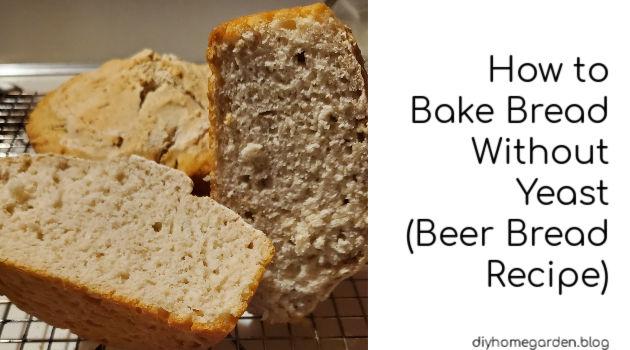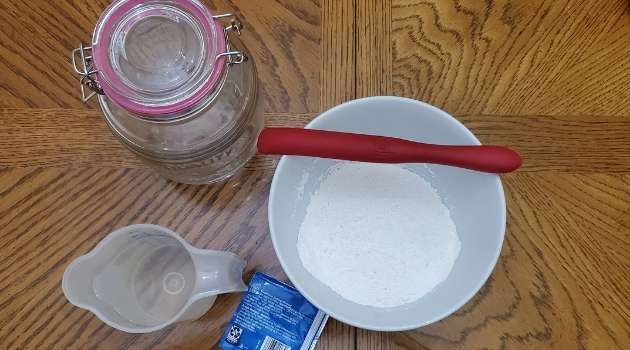During my adventures at the grocery store over the past two weeks, I started feeling like I was rewinding to 2020. Remember the bread, toilet paper, and egg shortages? Because I could not obtain a decent loaf of bread, I decided to make my sourdough starter recipe and keep it handy.
Some sourdough starter recipes are very fussy, with multiple steps and draining off liquid and daily feedings. I have used this starter in the past many times, and it does not need that constant tending. You’ll give it a quick stir once a day for the first few days. Nor does it demand any special ingredients that you would only find at a specialty grocer.
By the end of this article, you will know:
- Why you should try making sourdough starter
- Other ways to use sourdough starter in your cooking (besides baking bread)
- Health benefits of eating sourdough bread
- How to make a sourdough starter
- Caring for your sourdough starter
Why Make a Sourdough Starter?
Just as in 2020, the baking supplies in my local supermarket are extremely limited. With the shelves bare of bread (or bagels or English muffins), everyone wants to try their hand at baking bread. And why not? Freshly baked bread is one of life’s great pleasures.
Besides the delicious flavor of bread you get when you bake with this sourdough starter recipe, you also don’t need to worry about keeping yeast fresh. That’s because the yeast is already in the starter. So that’s another ingredient you won’t need to hunt for at the grocery store.
Once you learn how to easy it is to make a sourdough starter, you will wonder why you never gave it a try until now.

What Else Can You Do With Sourdough Starter?
Besides baking bread, you can make many delectable baked goods, like these:
- Sourdough cake.
- Sourdough biscuits (recipe here!)
- Sourdough chocolate cake. (Scrumptious!)
- Sourdough dinner rolls.
- Sourdough pancakes. (Easy to make!)
- Sourdough waffles.
- Sourdough muffins.
- Here’s my favorite–sourdough pizza crust.
You will expand your cooking options beyond your imagination and give old foods a fresh, new depth of flavor.
Four Key Benefits of Eating Sourdough Bread
Registered Dietitian Jessica Ball outlined four key benefits of eating sourdough-based baked goods in an article in EatingWell in 2021.
1 – Sourdough supports a healthy gut
Sourdough bread can improve gut health. The process of fermenting the sourdough starter increases the prebiotic and probiotic-like properties. Ball notes that the most beneficial flour to boost this result is rye flour.
2 – Easier to digest
Fermentation chemically alters the wheat enzymes that might irritate some people. So while sourdough is not a gluten-free bread, it is more digestible because of this chemical process.
3 – Helps to regulate blood glucose
If you have Type 2 diabetes or are on the borderline, you know the importance of monitoring your blood glucose level. Ball explains that sourdough is preferable over white or whole wheat bread because it has a lower glycemic index and glycemic load.
4 – Sourdough pairs well with a Mediterranean diet
Many medical professionals recommend that older adults eat a Mediterranean diet to support healthy aging. One study found that whole-wheat sourdough bread helped reduce the risk of diabetes and heart disease in some senior citizens.
So no, your bread will not be magically carb-free, but it looks like sourdough bread does offer some health advantages over traditionally baked offerings.
How to Make Sourdough Starter from Scratch
Here is how you can start the process.

Kitchen tools:
- A one-quart jar with a plastic or glass (must be non-metallic) lid
- Wooden spoon; vinyl or silicone spatula for stirring (again, no metal). I use my trusty spurtle, which long-time readers know I adore and use for almost everything.
- Measuring cups (liquid and dry)
Ingredients:
- Two cups of flour (all-purpose white, whole wheat, or rye, as you prefer)
- Two cups of warm tap water (100° F)
- One packet of yeast
Mixing the starter:
Put the water and yeast in the bottom of the one-quart jar and wait for it to start activating. You’ll know it’s ready when you see tiny bubbles. Add in the flour, stirring it in a little bit at a time. Continue to stir until you see no lumps in the flour. Cap the jar.
You might also want to set it on a pie pan or a large plate. The mixture might bubble and double in size, especially at high altitudes. So the dish will catch any bubbles that rise over the rim of the jar–it gets messy if this happens.
Store the jar at room temperature for the first few days. Stir it once per day for five days. Once it’s ready, you will notice an earthy, almost beer-like aroma–slightly sour yet not unpleasant. You are ready to bake or store it in the fridge until you use it.
How to Care for Your Sourdough Starter
The yeast in your starter is a living microorganism. Thus, it needs an occasional to remain active (alive).
After your first few days, you must use the starter, which many recipes refer to as sourdough discard. If you do not bake with it, you’ll still need to remove a cup of it after a few weeks to give it the fresh “food” it needs–more flour and water.
You will “feed” your starter in the same amount that you remove–50% flour and 50% water. In other words, if you remove one cup of sourdough starter to bake your favorite new pizza crust, you must replace it with 1/2 cup of flour and 1/2 cup of water. Stir it in and cap the jar. Let it sit out for twelve hours to promote fermentation, then place it into the fridge until your subsequent use.
If your starter develops a layer of liquid on the top, that is alcohol, a natural byproduct of fermentation. Skim it off and toss it down the drain. You have a mold problem if you see any odd purple, black, or greenish discoloration. Discontinue use and start a fresh batch.
If you take care of your sourdough starter, you can keep using it for many years. I had one jar that lasted over ten years. Then I dropped it, and I was super sad about it.
The Takeaway: This Sourdough Starter Recipe Is Uncomplicated
If you want to try your hand at baking a fresh, hot loaf of sourdough bread, but the starter instructions seem too complex, give this a try. It will provide you with a delicious final-baked loaf of bread without a complicated method. You will see that this starter is exceptionally versatile for many recipes.

